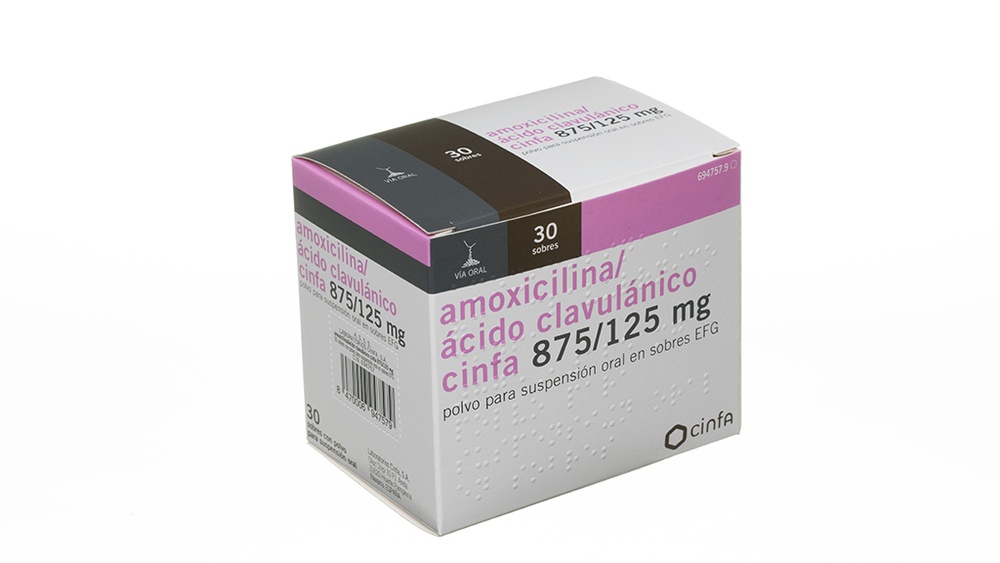

AMOXICILLIN/CLAVULANIC ACID Aurovitas 875 mg/125 mg ORAL SUSPENSION POWDER in sachets

Ask a doctor about a prescription for AMOXICILLIN/CLAVULANIC ACID Aurovitas 875 mg/125 mg ORAL SUSPENSION POWDER in sachets

How to use AMOXICILLIN/CLAVULANIC ACID Aurovitas 875 mg/125 mg ORAL SUSPENSION POWDER in sachets
Introduction
Package Leaflet: Information for the User
Amoxicillin/Clavulanic Acid Aurovitas 875 mg/125 mg Powder for Oral Suspension in Sachets EFG
Read all of this leaflet carefully before you start taking this medicine because it contains important information for you.
- Keep this leaflet, you may need to read it again.
- If you have any further questions, ask your doctor or pharmacist.
- This medicine has been prescribed for you only. Do not pass it on to others. It may harm them, even if their signs of illness are the same as yours.
- If you get any side effects, talk to your doctor, pharmacist or nurse. This includes any possible side effects not listed in this leaflet. See section 4.
Contents of the pack
- What Amoxicillin/Clavulanic Acid Aurovitas is and what it is used for
- What you need to know before you take Amoxicillin/Clavulanic Acid Aurovitas
- How to take Amoxicillin/Clavulanic Acid Aurovitas
- Possible side effects
- Storage of Amoxicillin/Clavulanic Acid Aurovitas
- Contents of the pack and other information
1. What Amoxicillin/Clavulanic Acid Aurovitas is and what it is used for
Amoxicillin/Clavulanic Acid Aurovitas is an antibiotic that eliminates the bacteria that cause infections. It contains two different active substances called amoxicillin and clavulanic acid. Amoxicillin belongs to a group of medicines known as "penicillins" which can sometimes lose their effectiveness (become inactivated). The other component (clavulanic acid) prevents this from happening.
Antibiotics are used to treat bacterial infections and are not effective against viral infections such as the flu or the common cold.
It is essential that you follow the instructions regarding dosage, administration interval, and treatment duration indicated by your doctor.
Do not store or reuse this medication. If you have any leftover antibiotic after completing treatment, return it to the pharmacy for proper disposal. Do not throw away medicines via wastewater or household waste.
Amoxicillin/Clavulanic Acid is used in adults and children to treat the following infections:
- Middle ear and sinus infections.
- Respiratory tract infections.
- Urinary tract infections.
- Skin and soft tissue infections, including dental infections.
- Bone and joint infections.
2. What you need to know before you take Amoxicillin/Clavulanic Acid Aurovitas
Do not takeAmoxicillin/Clavulanic Acid Aurovitas
- if you are allergic (hypersensitive) to amoxicillin, clavulanic acid, penicillins, or any of the other ingredients of this medicine (listed in section 6),
- if you have ever had a severe allergic reaction (hypersensitivity) to any other antibiotic. This could include skin rash or swelling of the face or throat,
- if you have ever had liver problems or jaundice (yellowing of the skin) when taking an antibiotic.
→Do not take amoxicillin/clavulanic acid if you are included in any of the above points.
Before starting treatment with amoxicillin/clavulanic acid, if you are unsure, consult your doctor or pharmacist.
Warnings and precautions
Consult your doctor or pharmacist before starting to take amoxicillin/clavulanic acid if:
- you have infectious mononucleosis,
- you are receiving treatment for liver or kidney problems,
- you do not urinate regularly.
If you are unsure whether any of the above symptoms affect you, inform your doctor or pharmacist before taking amoxicillin/clavulanic acid.
In some cases, your doctor may investigate the type of bacteria causing your infection. Depending on the results, you may be prescribed a different formulation of amoxicillin/clavulanic acid or another medication.
Symptoms to be aware of
Amoxicillin/Clavulanic Acid can worsen certain existing conditions or cause severe side effects. These include allergic reactions, seizures, and inflammation of the large intestine. You should be aware of certain symptoms while taking amoxicillin/clavulanic acid to reduce the risk of problems. See "Symptoms to be aware of" in section4.
Blood and urine tests
If you are having blood tests (such as red blood cell status or liver function studies) or urine tests (to check glucose levels), inform your doctor or nurse that you are taking amoxicillin/clavulanic acid. This is because amoxicillin/clavulanic acid can alter the results of these types of tests.
Other medicines and Amoxicillin/Clavulanic Acid Aurovitas
Tell your doctor or pharmacist if you are taking, have recently taken, or might take any other medicines.
If you are taking allopurinol (used for gout) with amoxicillin/clavulanic acid, you may be more likely to suffer a skin allergic reaction.
If you are taking probenecid (used to treat gout), concomitant use of probenecid may reduce the excretion of amoxicillin and is not recommended.
If you are taking anticoagulants (such as warfarin) with amoxicillin/clavulanic acid, more blood tests will be needed.
Amoxicillin/Clavulanic Acid can affect the action of methotrexate (a medicine used to treat cancer and rheumatic diseases).
Amoxicillin/Clavulanic Acid can affect how mycophenolate mofetil (a medicine used to prevent organ rejection in transplant patients) works.
Pregnancy, breastfeeding, and fertility
If you are pregnant or breastfeeding, think you may be pregnant, or are planning to have a baby, ask your doctor or pharmacist for advice before taking this medicine.
Driving and using machines
Amoxicillin/Clavulanic Acid can have side effects and the symptoms can make you unfit to drive. Do not drive or operate machinery unless you are feeling well.
Amoxicillin/Clavulanic Acid Aurovitas contains aspartame and maltodextrin
This medicine contains 22.5 mg of aspartame (E951) in each sachet. Aspartame is a source of phenylalanine, which may be harmful for people with phenylketonuria (a rare genetic disorder in which phenylalanine accumulates because the body is unable to remove it properly).
This medicine contains maltodextrin (glucose). If your doctor has told you that you have an intolerance to some sugars, contact them before taking this medicine.
3. How to take Amoxicillin/Clavulanic Acid Aurovitas
Always take this medicine exactly as your doctor or pharmacist has told you. If you are unsure, check with your doctor or pharmacist.
Adults and children over 40 kg
- Usual dose: 1 sachet twice a day.
- Higher dose: 1 sachet three times a day.
Children under 40 kg
Ask your doctor or pharmacist for advice when administering amoxicillin/clavulanic acid 875 mg/125 mg oral suspension in sachets to children who weigh less than 40 kg.
Patients with kidney and liver problems
- If you have kidney problems, your dose may be changed. Your doctor may choose a different formulation or another medicine.
- If you have liver problems, you will have more frequent blood tests to check how your liver is working.
How to take Amoxicillin/Clavulanic Acid Aurovitas
- Just before taking amoxicillin/clavulanic acid, open the sachet and mix the contents with half a glass of water.
- Take it at the start of meals or a while before.
- Space out the doses during the day, at least 4 hours apart. Do not take 2 doses in 1 hour.
- Do not take amoxicillin/clavulanic acid for more than 2 weeks. If you are still feeling unwell, consult your doctor.
If you take more Amoxicillin/Clavulanic Acid Aurovitas than you should
If you take too much amoxicillin/clavulanic acid, you may experience symptoms such as stomach upset (nausea, vomiting, or diarrhea) or seizures. Consult your doctor as soon as possible. Take the package with you to show the doctor.
In case of overdose or accidental ingestion, consult your doctor or pharmacist immediately or call the Toxicology Information Service, telephone 91 562 04 20, indicating the medicine and the amount taken.
If you forget to take Amoxicillin/Clavulanic Acid Aurovitas
If you forget to take a dose, take it as soon as you remember. Do not take the next dose too soon, wait at least 4 hours before taking the next dose. Do not take a double dose to make up for forgotten doses.
If you stop taking Amoxicillin/Clavulanic Acid Aurovitas
Continue taking amoxicillin/clavulanic acid until you finish the treatment, even if you feel better. You need to take the full treatment to cure the infection. If you do not, the bacteria that survive may cause you to have the infection again.
If you have any further questions on the use of this product, ask your doctor or pharmacist.
4. Possible side effects
Like all medicines, this medicine can cause side effects, although not everybody gets them. The following side effects may occur with this medicine.
Symptoms to be aware of:
Allergic reactions:
- Skin rash.
- Inflammation of blood vessels (vasculitis) that can appear as red or purple spots on the skin but can affect other parts of the body.
- Fever, joint pain, swollen glands in the neck, armpits, or groin.
- Swelling, sometimes of the face or throat (angioedema), which can cause difficulty breathing.
- Collapse.
- Chest pain in the context of allergic reactions, which can be a symptom of allergy-induced heart attack (Kounis syndrome).
→ Contact your doctor immediatelyif you experience any of these symptoms. Stop taking amoxicillin/clavulanic acid.
Inflammation of thelarge intestine:
Inflammation of the large intestine, which causes watery diarrhea, usually with blood and mucus,
stomach pain and/or fever.
Acute pancreatitis (inflammation of the pancreas)
If you have severe and persistent stomach pain, this could be a sign of acute pancreatitis.
Drug-induced enterocolitis syndrome (DIES):
DIES has been reported mainly in children receiving amoxicillin/clavulanic acid. It is a certain type of allergic reaction with the main symptom of repeated vomiting (1-4 hours after taking the medicine). Other symptoms may include abdominal pain, lethargy, diarrhea, and low blood pressure.
→ Contact your doctor as soon as possiblefor advice if you have these symptoms.
Very common side effects(may affect more than 1 in 10 people):
- Diarrhea (in adults).
Common side effects(may affect up to 1 in 10 people):
- Thrush (Candida - fungal infection of the vagina, mouth, or mucous membranes).
- Discomfort (nausea), especially when taking high doses.
→ if this happens, take amoxicillin/clavulanic acid with meals:
- Vomiting.
- Diarrhea (in children).
Uncommon side effects(may affect up to 1 in 100 people):
- Skin rash, itching.
- Increased pruritic rash (urticarial rash).
- Indigestion.
- Dizziness.
- Headache.
Uncommon side effects that may appear in your blood tests:
- Increased levels of certain substances (enzymes) produced by the liver.
Rare side effects(may affect up to 1 in 1,000 people):
- Skin rash, which can form blisters that look like small targets (central dark spot surrounded by a paler area, with a dark ring around the edge - erythema multiforme).
→If you have any of these symptoms, consult a doctor urgently.
Rare side effects that may appear in your blood tests:
- Low count of cells involved in blood clotting.
- Low white blood cell count.
Other side effects(Frequency not known: cannot be estimated from the available data):
- Allergic reactions (see above).
- Inflammation of the large intestine (see above).
- Crystals in the urine that cause acute kidney injury.
- Inflammation of the protective membranes surrounding the brain and spinal cord (aseptic meningitis).
- Severe skin reactions:
- widespread rash with blisters and peeling of the skin, particularly around the mouth, nose, eyes, and genitals (Stevens-Johnson syndrome), and in its most severe form, causing widespread peeling of the skin (more than 30% of the body surface - toxic epidermal necrolysis),
- red rash with small blisters containing pus (bullous exfoliative dermatitis),
- red exfoliative rash, with bumps under the skin and blisters (pustular exanthematous),
- flu-like symptoms with skin rash, fever, swollen glands, and abnormal blood test results (such as elevated white blood cell count (eosinophilia) and liver enzymes) (drug reaction with eosinophilia and systemic symptoms (DRESS)),
- chest pain in the context of allergic reactions, which can be a symptom of allergy-induced heart attack (Kounis syndrome).
- rash with blisters arranged in a circle with a central crust or like a necklace (linear IgA disease).
→ Contact a doctor immediately if you have any of these symptoms.
- Inflammation of the liver (hepatitis).
- Jaundice, caused by an increase in bilirubin in the blood (a substance produced by the liver) that can make the skin and the whites of the eyes turn yellow.
- Inflammation of the kidney ducts.
- Delayed blood clotting.
- Hyperactivity.
- Seizures (in patients taking high doses of amoxicillin/clavulanic acid or with kidney problems).
- Black hairy tongue.
- Stained teeth (in children), which usually disappears with brushing.
Side effects that may appear in your blood or urine tests:
- Significant reduction in the number of white blood cells.
- Low red blood cell count (hemolytic anemia).
Reporting of side effects
If you experience any side effects, talk to your doctor, pharmacist, or nurse, even if it is a possible side effect not listed in this leaflet. You can also report side effects directly through the Spanish Medicines Monitoring System for Human Use: https://www.notificaram.es. By reporting side effects, you can help provide more information on the safety of this medicine.
5. Storage of Amoxicillin/Clavulanic Acid Aurovitas
Keep this medicine out of the sight and reach of children.
Do not use this medicine after the expiry date which is stated on the sachet and the carton after EXP. The expiry date is the last day of the month shown.
Store below 30°C.
Store in the original package to protect from light.
Medicines should not be disposed of via wastewater or household waste. Return the containers and any unused medicines to the pharmacy. Ask your pharmacist how to dispose of containers and any unused medicines. This will help protect the environment.
6. Container Content and Additional Information
Composition ofAmoxicillin/Clavulanic Acid Aurovitas
- The active ingredients are amoxicillin and clavulanic acid. Each sachet contains amoxicillin trihydrate equivalent to 875 mg of amoxicillin and potassium clavulanate equivalent to 125 mg of clavulanic acid.
- The other components (excipients) are: Crospovidone (Type-A), magnesium stearate, silicon dioxide, and aspartame (E 951).
Composition of strawberry guarana flavor: corn maltodextrin, propylene glycol (E1520), flavoring substances, triethyl citrate (E1505), flavoring preparations.
Composition of lemon flavor: natural flavoring substances, flavoring preparations, flavoring substances, corn maltodextrin, alpha-tocopherol (E307).
Composition of peach flavor: corn maltodextrin, glycerol triacetate (E1518), flavoring substances, flavoring preparations, natural flavoring substances.
- See section 2 for more important information about some of the components of this medicine.
Appearance of the Product and Container Content
Oral suspension powder in sachets.
Powder of white to pale yellow color.
Amoxicillin/Clavulanic Acid Aurovitas 875 mg/125 mg oral suspension powder is available in sachets.
Container sizes: 8, 12, 20, or 30 sachets.
Only some container sizes may be marketed.
Marketing Authorization Holder and Manufacturer
Marketing Authorization Holder:
Aurovitas Spain, S.A.U.
Avda. de Burgos, 16-D
28036 Madrid
Spain
Manufacturer:
APL Swift Services (Malta) Limited
HF26, Hal Far Industrial Estate, Hal Far
Birzebbugia, BBG 3000
Malta
Or
Generis Farmacêutica, S.A.
Rua João de Deus, 19
2700-487 Amadora, Lisboa
Portugal
Or
Arrow Génériques
26 Avenue Tony Garnier,
Lyon, Rhone 69007,
France
This medicine is authorized in the Member States of the European Economic Area under the following names:
Spain:Amoxicillin/Clavulanic Acid Aurovitas 875 mg/125 mg oral suspension powder in sachets EFG
France:AMOXICILLINE/ACIDE CLAVULANIQUE ARROW LAB 1 g/125 mg, powder for oral suspension in sachet-dose (amoxicillin/clavulanic acid ratio: 8/1)
Italy:Amoxicillin/Clavulanic Acid Aurobindo Pharma Italia
Malta:Amoxicillin/Clavulanic Acid Aurobindo 875 mg/125 mg powder for oral suspension in sachet
Date of the Last Revision of this Leaflet:
August 2023
Detailed information about this medicine is available on the website of the Spanish Agency for Medicines and Health Products (AEMPS) (http://www.aemps.gob.es)
Medical Advice/Education Antibiotics are used to treat infections caused by bacteria. They have no effect against infections caused by viruses. Sometimes, a bacterial infection does not respond to a course of an antibiotic. One of the most common reasons for this to happen is that the bacteria that cause the infection are resistant to the antibiotic being taken. This means they can survive and even multiply despite the antibiotic. Bacteria can become resistant to antibiotics for many reasons. Careful use of antibiotics can help reduce the likelihood of bacteria becoming resistant to them. When your doctor prescribes an antibiotic treatment, it is only intended to treat your current illness. Paying attention to the following tips will help prevent the appearance of resistant bacteria that could stop the antibiotic from working.
|
---------------------------------------------------------------------------------------------------------------------------
Reconstitution Instructions
Pour the contents of the sachet into a half glass of water, shake until a suspension is obtained, and take immediately.

How much does AMOXICILLIN/CLAVULANIC ACID Aurovitas 875 mg/125 mg ORAL SUSPENSION POWDER in sachets cost in Spain ( 2025)?
The average price of AMOXICILLIN/CLAVULANIC ACID Aurovitas 875 mg/125 mg ORAL SUSPENSION POWDER in sachets in November, 2025 is around 6.81 EUR. Prices may vary depending on the region, pharmacy, and whether a prescription is required. Always check with a local pharmacy or online source for the most accurate information.
- Country of registration
- Average pharmacy price6.81 EUR
- Active substance
- Prescription requiredYes
- Manufacturer
- This information is for reference only and does not constitute medical advice. Always consult a licensed doctor before taking any medication. Oladoctor is not responsible for medical decisions based on this content.
- Alternatives to AMOXICILLIN/CLAVULANIC ACID Aurovitas 875 mg/125 mg ORAL SUSPENSION POWDER in sachetsDosage form: ORAL SOLUTION/SUSPENSION, 250 mg amoxicillin/62.5 mg clavulanic acidActive substance: amoxicillin and beta-lactamase inhibitorManufacturer: Sandoz Farmaceutica S.A.Prescription requiredDosage form: INJECTABLE PERFUSION, 2 g / 200 mgActive substance: amoxicillin and beta-lactamase inhibitorManufacturer: Laboratorio Reig Jofre, S.A.Prescription requiredDosage form: TABLET, 500 mg amoxicillin/125 mg clavulanic acidActive substance: amoxicillin and beta-lactamase inhibitorManufacturer: Sun Pharmaceutical Industries (Europe) B.V.Prescription required
Alternatives to AMOXICILLIN/CLAVULANIC ACID Aurovitas 875 mg/125 mg ORAL SUSPENSION POWDER in sachets in other countries
The best alternatives with the same active ingredient and therapeutic effect.
Alternative to AMOXICILLIN/CLAVULANIC ACID Aurovitas 875 mg/125 mg ORAL SUSPENSION POWDER in sachets in Poland
Alternative to AMOXICILLIN/CLAVULANIC ACID Aurovitas 875 mg/125 mg ORAL SUSPENSION POWDER in sachets in Ukraine
Online doctors for AMOXICILLIN/CLAVULANIC ACID Aurovitas 875 mg/125 mg ORAL SUSPENSION POWDER in sachets
Discuss dosage, side effects, interactions, contraindications, and prescription renewal for AMOXICILLIN/CLAVULANIC ACID Aurovitas 875 mg/125 mg ORAL SUSPENSION POWDER in sachets – subject to medical assessment and local rules.















